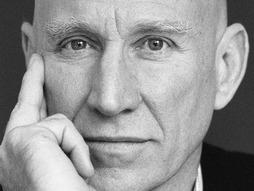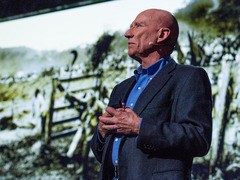Saif EL Masry
الدراما الصامته للتصوير
المصور الوحيد الذى عشقته و بين الحين و الاخر اشاهد اعماله لا اشبع منها ابدا
المصور الوحيد الذى اجده قريب جدا من قلبي
المصور الوحيد الذى اطلق عليه مصور
فديو رائع لانسان اروع

الدكتور المصور سيباستياو سالغادو
الحائز على الدكتوراة في الإقتصاد (سيباستياو سالغادو) بدأ التصوير في الثلاثينيات من عمره ، و لكن الإلتزام صار هوساً بالنسبة له. مشاريعه التي إستمرت لسنين صوّرت بشكل جميل الجانب البشري من القصة العالمية التي غالباً ما تتضمن الموت ، الدمار أو الخراب. هنا يخبرنا بقصة شخصية عميقة عن الحرفة التي كادت تنهي حياته، و يرينا صوراً حابسة للأنفاس عن عمله الأخير جينيسيس (التكوين بالعربية) الذي يوثق الناس و الأماكن المنسية في العالم.
Interactive transcriptInteractive transcript
Sebastião Salgado
Photojournalist

تابعوا هذا الفيديو الرائع

Personal profile
Sebastião Salgado captures the dignity of the dispossessed through large-scale, long-term projects.
Why you should listen
A gold miner in Serra Pelada, Brazil; a Siberian Nenet tribe that lives in -35°C temperatures; a Namibian gemsbok antelope. These are just a few of the subjects from Sebastião Salgado’s immense collection of work devoted to the world’s most dispossessed and unknown.
Brazilian-born Salgado, who shoots only using Kodak film, is known for his incredibly long-term projects, which require extensive travel and extreme lifestyle changes. Workers took seven years to complete and contained images of manual laborers from 26 countries, while Migrations took six years in 43 different countries on all seven continents. Most recently Salgado completed Genesis, an ambitious eight-year project that spanned 30 trips to the world’s most pristine territories, land untouched by technology and modern life. Among Salgado’s many travels for Genesis was a two-month hike through Ethiopia, spanning 500 miles with 18 pack donkeys and their riders. In the words of Brett Abbott, a Getty Museum curator, Salgado’s approach can only be described as “epic.”
What others say
“Other photojournalists go in and out for a day. Sebastião goes and lives with his subjects for weeks before he even takes a picture.” — Peter Fetterman, in The New York Times


